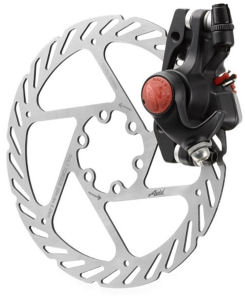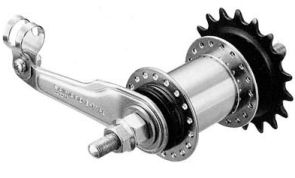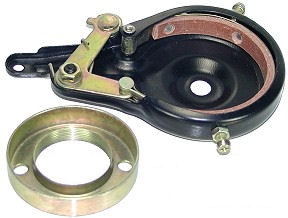
|

This page is intended to point out the advantages of different types of bicycle brakes, and to link to separate articles about them.
Also see the table of contents page covering articles about brakes.
Brakes use friction to convert kinetic energy into heat. Pads of one type or another press against the wheel rim, a drum or disc,which dissipates most of the heat, as the pads are smaller, sometimes enclosed, and often of a material which conducts heat poorly.. The surface of the pads is in contact with the rim or disc, and so it is at the same temperature.
A bicycle brake may work at the rim, or at the hub.
Rim brakes have the advantages of light weight, large heat-dissipating area, and low stress on the bicycle frame, fork and wheel.
Hub brakes are more weatherproof, and and are not affected by rim dents or wheel true. Because heat-dissipating area is smaller than with rim brakes, these brakes run hot -- but some are designed to.
Bicycle brakes are operated by hand levers by way of cables, or sometimes hydraulic lines -- except for one type of rear hub brake, called in British English a "backpedaling brake" or "foot brake". In American English, it is called a "coaster brake", an expression which dates back to the its introduction in the late 19th century -- also allowing coasting, unlike a fixed gear.
Most cable-operated disc brakes, and direct-pull brakes (one kind of rim brake, also called V brakes) require special brake levers, mostly available for flat handlebars. About these brake levers, please see Tom Deakins's page about handlebars.
There is also a page about cables on this site. Poor brake performance often results from cable problems.
![]()
![]()
Different types of riding favor different brakes.
 The Shimano Rollerbrake is a variety of drum brake that attaches to the hub with a special fitting which is found only on Shimano Nexus and Nexave hubs. As an external brake, a Rollerbrake can be replaced separately from the hub. Several sizes are available. Also see the article about Rollerbrakes.
The Shimano Rollerbrake is a variety of drum brake that attaches to the hub with a special fitting which is found only on Shimano Nexus and Nexave hubs. As an external brake, a Rollerbrake can be replaced separately from the hub. Several sizes are available. Also see the article about Rollerbrakes. Disc brakes are designed so they can run hot, and dissipate heat better than most drum brakes. You may smell hot metal if you are using disc brakes to hold down your speed on a long, steep downgrade. Disc-brake rotors are of steel, and most of the radiating area is in the brake track. Steel transmits heat quite well, but relatively little heat is transferred along the narrow spokes of the disc toward the hub.
Disc brakes have become popular on mountain bikes and are gaining popularity for other bicycles. Disc brakes can only be installed on frames with special fittings, and have unique problems, worst among which is that a front disc brake can pull the wheel out of the fork. Also see the article about disc brakes.
Disc brakes are designed so they can run hot, and dissipate heat better than most drum brakes. You may smell hot metal if you are using disc brakes to hold down your speed on a long, steep downgrade. Disc-brake rotors are of steel, and most of the radiating area is in the brake track. Steel transmits heat quite well, but relatively little heat is transferred along the narrow spokes of the disc toward the hub.
Disc brakes have become popular on mountain bikes and are gaining popularity for other bicycles. Disc brakes can only be installed on frames with special fittings, and have unique problems, worst among which is that a front disc brake can pull the wheel out of the fork. Also see the article about disc brakes.  A coaster brake is operated by backpedaling, and so can be installed only on the rear wheel. Coaster brakes are the most maintenance-free, and are suitable for children with limited hand strength. On a folding or take-apart bicycle, a coaster brake avoids the need for a cable connection. A coaster brake complicates starting and stopping, and prevents the use of toe clips and straps, clipless pedals or derailer gearing. A coaster brake may, however. be incorporated into an internal-gear hub --- but then, except with a two-speed kickback hub, a shifter cable is needed. A coaster brake is OK for utility cycling but unsuitable for speed control on long downhill runs. Also see the article about coaster brakes. A coaster brake is often installed as the only brake on a bicycle -- but every bicycle should have two brakes because every brake fails sooner or later.
A coaster brake is operated by backpedaling, and so can be installed only on the rear wheel. Coaster brakes are the most maintenance-free, and are suitable for children with limited hand strength. On a folding or take-apart bicycle, a coaster brake avoids the need for a cable connection. A coaster brake complicates starting and stopping, and prevents the use of toe clips and straps, clipless pedals or derailer gearing. A coaster brake may, however. be incorporated into an internal-gear hub --- but then, except with a two-speed kickback hub, a shifter cable is needed. A coaster brake is OK for utility cycling but unsuitable for speed control on long downhill runs. Also see the article about coaster brakes. A coaster brake is often installed as the only brake on a bicycle -- but every bicycle should have two brakes because every brake fails sooner or later. Band brakes have a flexible band which wraps around the outside of a brake drum and is tightened to apply the brake. These brakes are light in weight but have many disadvantages. Also see the article about band brakes.
Band brakes have a flexible band which wraps around the outside of a brake drum and is tightened to apply the brake. These brakes are light in weight but have many disadvantages. Also see the article about band brakes.With only a few exceptions, every bicycle should be equipped with two brakes -- front, and rear. Again: any brake will fail sooner or later, and then you really need the other one!
Notable exceptions are:
![]()
![]()
Last Updated: by John Allen